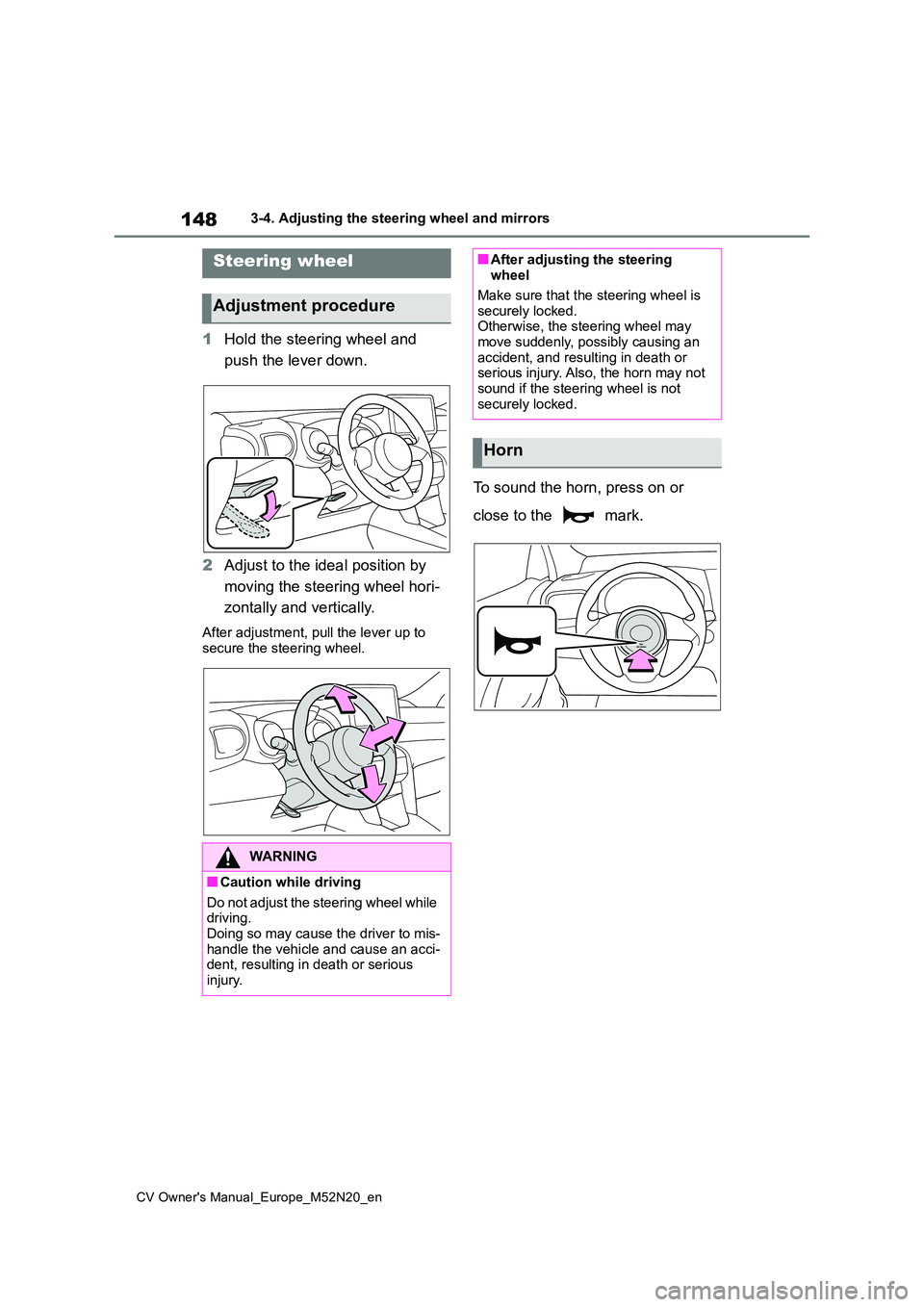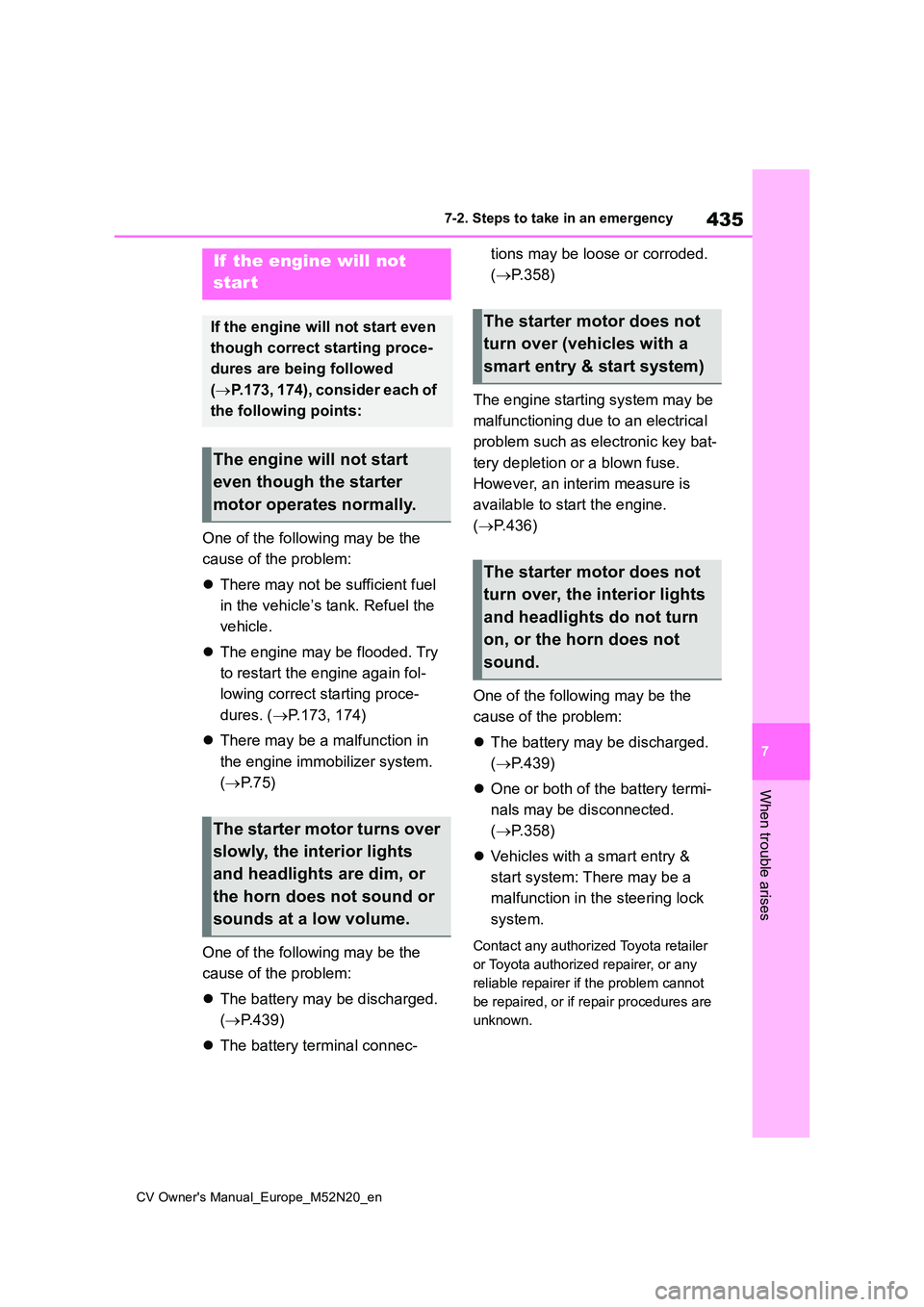2022 TOYOTA YARIS CROSS horn
[x] Cancel search: hornPage 150 of 618

148
CV Owner's Manual_Europe_M52N20_en
3-4. Adjusting the steering wheel and mirrors
3-4.Adjusting the steering whe el an d mirrors
1Hold the steering wheel and
push the lever down.
2 Adjust to the ideal position by
moving the steering wheel hori-
zontally and vertically.
After adjustment, pull the lever up to
secure the steering wheel.
To sound the horn, press on or
close to the mark.
Steering wheel
Adjustment procedure
WARNING
■Caution while driving
Do not adjust the steering wheel while driving.Doing so may cause the driver to mis-
handle the vehicle and cause an acci- dent, resulting in death or serious injury.
■After adjusting the steering wheel
Make sure that the steering wheel is
securely locked. Otherwise, the steering wheel may move suddenly, possibly causing an
accident, and resulting in death or serious injury. Also, the horn may not sound if the steering wheel is not
securely locked.
Horn
Page 282 of 618

280
CV Owner's Manual_Europe_M52N20_en
4-5. Using the driving support systems
●The following situations may occur
during use. • Depending on the shape of the object and other factors, the detection dis-
tance may shorten, or detection may be impossible.• Detection may be impossible if static
objects draw too close to the sensor. • There will be a short delay between static object detection and display
(warning buzzer sounds). Even at low speeds, there is a possibility that the object will come within 30 cm (1.0 ft.)
before the display is shown and the warning buzzer sounds.• It might be difficult to hear the buzzer
due to the volume of the audio system or air flow noise of the air conditioning system.
• It may be difficult to hear the sound of this system due to the buzzers of other systems.
■Objects which the system may not
be properly detected
The shape of the object may prevent the sensor from detecting it. Pay particular
attention to the following objects:
●Wires, fences, ropes, etc.
●Cotton, snow and other materials that absorb sound waves
●Sharply-angled objects
●Low objects
●Tall objects with upper sections pro-
jecting outwards in the direction of your vehicle
■Situations in which the system may not operate properly
Certain vehicle conditions and the sur- rounding environment may affect the ability of a sensor to correctly detect
objects. Particular instances where this may occur are listed below.
●There is dirt, snow, water drops or ice on a sensor. (Cleaning the sensors will resolve this problem.)
●A sensor is frozen. (Thawing the area will resolve this problem.)
In especially cold weather, if a sensor
is frozen the sensor display may be
displayed abnormally, or objects, such as a wall, may not be detected.
●When a sensor or the area around a sensor is extremely hot or cold.
●On an extremely bumpy road, on an incline, on gravel, or on grass.
●When vehicle horns, vehicle detec-tors, motorcycle engines, air brakes of large vehicles, the clearance sonar of
other vehicles or other devices which produce ultrasonic waves are near the vehicle
●A sensor is coated with a sheet of spray or heavy rain.
●If objects draw too close to the sensor.
●Pedestrians that are hard to reflect ultrasonic waves (ex. skirts with gath-ers or frills).
●When objects that are not perpendicu-lar to the ground, not perpendicular to
the vehicle traveling direction, uneven, or waving are in the detection range.
●Strong wind is blowing
●When driving in inclement weather such as fog, snow or a sandstorm
●When an object that cannot be detected is between the vehicle and a detected object
●If an object such as a vehicle, motor-cycle, bicycle or pedestrian cuts in
front of the vehicle or runs out from the side of the vehicle
●If the orientation of a sensor has been changed due to a collision or other impact
●When equipment that may obstruct a
Page 283 of 618

281
4
CV Owner's Manual_Europe_M52N20_en
4-5. Using the driving support systems
Driving
sensor is installed, such as a towing
eyelet, bumper protector (an addi- tional trim strip, etc.), bicycle carrier, or snow plow
●If the front of the vehicle is raised or lowered due to the carried load
●If the vehicle cannot be driven in a stable manner, such as when the
vehicle has been in an accident or is malfunctioning
●When a tire chains, compact spare tire or an emergency tire puncture repair kit is used
■Situations in which the system may
operate even if there is no possibil- ity of a collision
In some situations, such as the follow-
ing, the system may operate even though there is no possibility of a colli-sion.
●When driving on a narrow road
●When driving toward a banner, flag, low-hanging branch or boom barrier (such as those used at railroad cross-
ings, toll gates and parking lots)
●When there is a rut or hole in the sur-
face of the road
●When driving on a metal cover (grat-
ing), such as those used for drainage ditches
●When driving up or down a steep slope
●If a sensor is hit by a large amount of water, such as when driving on a flooded road
●There is dirt, snow, water drops or ice on a sensor. (Cleaning the sensors
will resolve this problem.)
●A sensor is coated with a sheet of
spray or heavy rain
●When driving in inclement weather
such as fog, snow or a sandstorm
●When strong winds are blowing
●When vehicle horns, vehicle detec- tors, motorcycle engines, air brakes of
large vehicles, the clearance sonar of other vehicles or other devices which produce ultrasonic waves are near the
vehicle
●If the front of the vehicle is raised or
lowered due to the carried load
●If the orientation of a sensor has been
changed due to a collision or other impact
●The vehicle is approaching a tall or curved curb
●Driving close to columns (H-shaped steel beams, etc.) in multi-story park-ing garages, construction sites, etc.
●If the vehicle cannot be driven in a stable manner, such as when the
vehicle has been in an accident or is malfunctioning
●On an extremely bumpy road, on an incline, on gravel, or on grass
●When a tire chains, compact spare tire or an emergency tire puncture repair kit is used
Page 437 of 618

435
7
CV Owner's Manual_Europe_M52N20_en
7-2. Steps to take in an emergency
When trouble arises
One of the following may be the
cause of the problem:
There may not be sufficient fuel
in the vehicle’s tank. Refuel the
vehicle.
The engine may be flooded. Try
to restart the engine again fol-
lowing correct starting proce-
dures. ( P.173, 174)
There may be a malfunction in
the engine immobilizer system.
( P. 7 5 )
One of the following may be the
cause of the problem:
The battery may be discharged.
( P.439)
The battery terminal connec-
tions may be loose or corroded.
( P.358)
The engine starting system may be
malfunctioning due to an electrical
problem such as electronic key bat-
tery depletion or a blown fuse.
However, an interim measure is
available to start the engine.
( P.436)
One of the following may be the
cause of the problem:
The battery may be discharged.
( P.439)
One or both of the battery termi-
nals may be disconnected.
( P.358)
Vehicles with a smart entry &
start system: There may be a
malfunction in the steering lock
system.
Contact any authorized Toyota retailer
or Toyota authorized repairer, or any
reliable repairer if the problem cannot
be repaired, or if repair procedures are
unknown.
If the engine will not
start
If the engine will not start even
though correct starting proce-
dures are being followed
( P.173, 174), consider each of
the following points:
The engine will not start
even though the starter
motor operates normally.
The starter motor turns over
slowly, the interior lights
and headlights are dim, or
the horn does not sound or
sounds at a low volume.
The starter motor does not
turn over (vehicles with a
smart entry & start system)
The starter motor does not
turn over, the interior lights
and headlights do not turn
on, or the horn does not
sound.
Page 474 of 618

472
CV Owner's Manual_Europe_M52N20_en
What to do if... (Troubleshooting)
Is the parking brake released?
( P. 1 8 6)
Depending on the situation, other
types of warning buzzer may also
sound. ( P.403, 413)
Did anyone inside the vehicle
open a door during setting the
alarm?
The sensor detects it and the alarm
sounds. ( P. 7 7)
Do one of the following to deacti-
vate or stop the alarms:
Unlock the doors using the entry
function (if equipped) or wireless
remote control.
Starting the engine. (The alarm
will be deactivated or stopped
after a few seconds.)
Is the electronic key left inside
the vehicle?
Check the message on the multi-infor-
mation display. ( P.413)
When a warning light turns on or
a warning message is displayed,
refer to P.403, 413.
Vehicles with an emergency tire
puncture repair kit: Stop the vehi-
cle in a safe place and repair the
flat tire temporarily with the
emergency tire puncture repair
kit. ( P.415)
Vehicles with spare tire: Stop the
vehicle in a safe place and
replace the flat tire with the spare
tire. ( P.426)
Try the procedure for when the
vehicle becomes stuck in mud,
dirt, or snow. ( P.444)
An alarm is activated and the
horn sounds (vehicles with
an alarm)
A warning buzzer sounds
when leaving the vehicle
(vehicles with a smart entry
& start system)
A warning light turns on or a
warning message is dis-
played
When a problem has
occurred
If you have a flat tire
The vehicle becomes stuck
Page 479 of 618

477
CV Owner's Manual_Europe_M52N20_en
Alphabetical Index
Front turn signal lights ................ 186
Replacing light bulbs .......... 387, 388
Turn signal lever ........................ 186
Wattage ...................................... 455
Fuel ................................................ 210
Capacity ..................................... 450
Fuel gauge ............................. 85, 89
Fuel pump shut off system ......... 402
Information ................................. 456
Refueling .................................... 210
Type ........................................... 450
Warning light .............................. 406
Fuel consumption
Average fuel economy ......... 96, 101
Current fuel consumption ..... 96, 101
Fuel economy ......................... 96, 101
Fuel filler door .............................. 210
Refueling .................................... 210
Fuel gauge ................................ 85, 89
Fuel pump shut off system .......... 402
Fuses ............................................. 381
G
Gauges ...................................... 85, 89
Gear Shift Indicator ...................... 185
Glove box ...................................... 327
GPF (Gasoline Particulate Filter)
system ......................................... 300
H
Hands Free Power Back Door ..... 128
Head restraints ............................. 144
Head-up display ............................ 106
Driving information display area. 106
Driving support system display area
................................................. 108
Eco Driving Indicator .................. 109
Navigation system-linked display
area .......................................... 108
Pop-up display ........................... 108
Settings ...................................... 107
Headlights
Adaptive High-beam System...... 197
Automatic High Beam system .... 201
Extended headlight lighting function
................................................. 194
Light switch ................................ 192
Replacing light bulbs ..................387
Wattage ...................................... 455
Heated steering wheel ..................322
Heaters
Automatic air conditioning system
................................................. 316
Heated steering wheel ............... 322
Heater system ............................ 312
Manual air conditioning system .. 312
Outside rear view mirrors ... 313, 318
Seat heaters ............................... 322
High mounted stoplight
Replacing light bulbs ..................387
Hill-start assist control ................. 301
Hood............................................... 351
Open .......................................... 351
Hooks
Coat hooks ................................. 339
Retaining hooks (floor mat) .......... 32
Horn ............................................... 148
I
Identification
Engine ........................................449
Vehicle........................................448